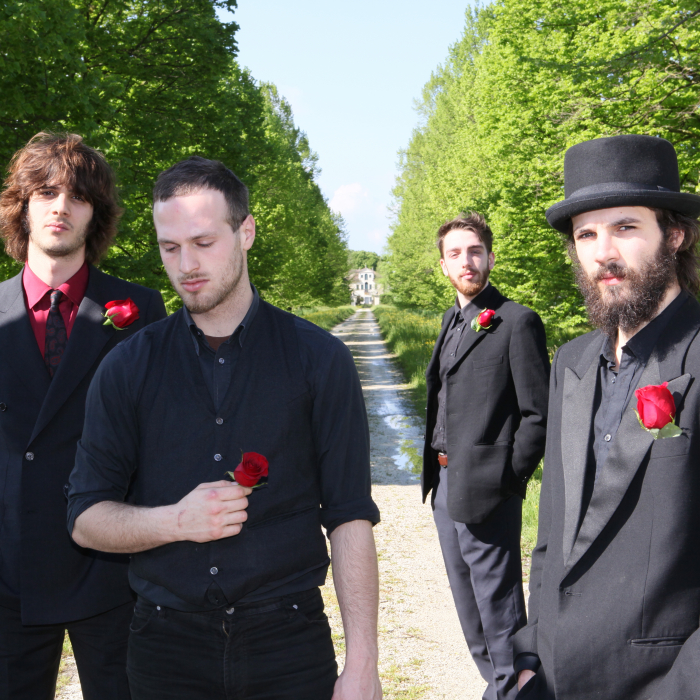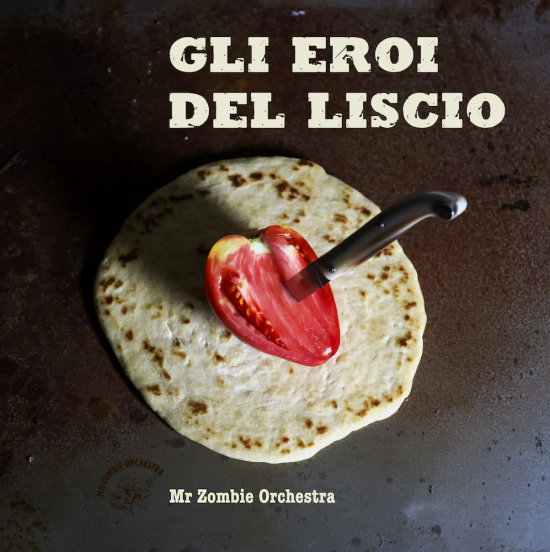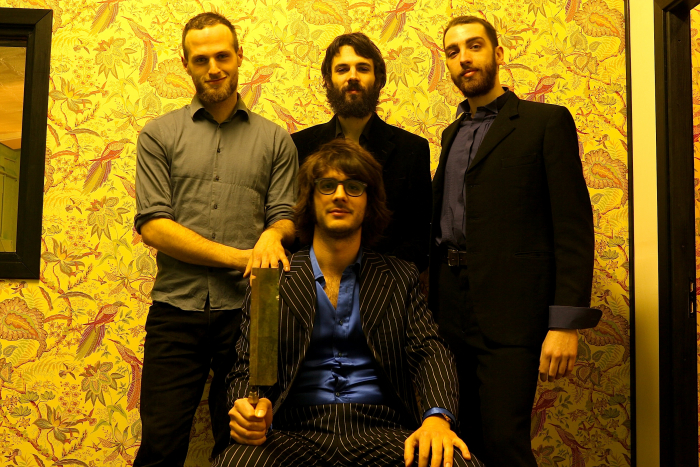My meeting with Alberto Bazzoli took place in the amazing recording studio called by the evocative name “L’amor mio non muore” (My love does not die), located in the province of Forlì.
Meeting the need for an alternative solution to the modern standard recording and production techniques, the studio provides vintage and analogue equipment (one of their mottos is “fuck the digital era”).
I met Alberto for the first time a few years ago; he was a member of a music group that, as very few artists can do nowadays, is able to tug at your heartstrings, combining formal complexity and richness of timbre: the Collettivo Ginsberg, a project born in 2004. The word collettivo [collective] indicates the variety of people, musicians and artists that have taken part in the project; the reference to Allen Ginsberg reflects the search for a well-defined literary style, evoking profound and oneiric elements, from the beat generation to the dialect poetry of Romagna. The Collettivo’s music has deep and complex roots, and mixed origins: it draws its inspiration from traditional sounds in order to create something new, unrelated to any genre or style code. Following two self-produced records, one EP in 2012, one LP called Asa Nisi Masa in 2013 and a tribute record to The Doors in 2014, their mature album Tropico was released in September 2016 by the label L’amor mio non muore (the same label that produced Portobello by Supermarket, the band featured in the May 2017 Illustrati issue).
This was just to point out some connections and offer you a complete overview.
Now we are going to deal with another one of Alberto’s projects, and he will talk about it himself.
«Mr Zombie Orchestra is a quartet made up of myself (keyboards), Riccardo Morandini (electric guitar), Gabriele Laghi (electric double bass), and Eugenio Primo Saragoni (drums).
The group makes up the Collettivo Ginsberg’s instrumental wing. It was founded in 2012 after an eight-year experience in the Collettivo: at one point I simply wanted to involve the musicians I used to play with more often in a discovery journey through the dance music of the past. At first, we had a broader general idea: our repertoire included tangos, swings and some traditional songs from Romagna. We introduced ourselves as “an electric quartet that messes up the musical tradition of the balera.” The group members were going through their jazz phase and I had recently been to New Orleans: that experience had forced me to think over my musical roots. Why not reproduce the traditional sounds of my land with a jazz approach? The project started off with a great variety of dancing pieces: tangos, waltzes, swings, ballads and all-time classics, spiced up by improvisation (an element that partially disappeared from our most recent works).
We recorded our first album called Someone like it zombie! with the audiophile label Velut Luna, based in Padua and directed by Marco Lincetto: it featured covers of all-time classics, like “Tramonto” by Secondo Casadei.
The following year we noticed that many musicians were beginning to experiment with the liscio genre. I remember that during the recording of our second album, completely focused on the music from Romagna, I learned about Vanni Crociani’s project “Dal vangelo Secondo” (a tribute to the father of liscio) and about Guglielmo Pagnozzi’s (a jazz musician from Bologna) liscio projects. I was really impressed to see how many artists were heading in the same direction, unaware of each other’s work!
We put our material together and produced the second album, C’era una volta in Romagna, again with the Velut Luna label. We placed a mobile recording studio inside the abandoned theatre of Brisighella, a small town in the province of Ravenna. All songs were by Secondo Casadei, except for one track by Ivano Nicolucci and one by Ferrer Rossi. In this record, the improvisation technique – which is still one of our trademarks and a vital element in our live shows – was put aside to make room for arrangements. Thanks to this record we had the opportunity to reach a broader audience, we met Riccarda Casadei, took part in La Notte del Liscio and played around a lot.
Now let’s jump to 2015, when we started to work on our so-called mature album: half of the tracks in this record, entitled Gli eroi del liscio (the cover shows a piadina bread stabbed by a knife) were original instrumental songs inspired by the music from Romagna we had been studying for years, while the other half were virtuoso pieces from the late liscio repertoire, mainly focused on “athletic” performances.
This is definitely the most iconic album by Mr Zombie Orchestra… but it has never been released because the band has gradually fallen apart. The good news is that I’ve recently decided to release the record anyway, within the year 2017.
The goal of Mr Zombie Orchestra has always been to “overturn liscio standards”, therefore traditional melodies are often played with distorted guitars, synth or Hammond organ. We have always tried to stick to the original rhythms of the songs and to the clear – although reinterpreted – distinction between the three ultimate dance genres (waltz, mazurka, and polka). But I have to say that over time the mazurkas have turned into “afro-beat” rhythms and the polkas have become a New Orleans-style brass parade. Even if we’ve tried to faithfully reproduce liscio themes, the sounds and the arrangements have changed, and we have added improvised rock bits, which might sound somehow sloppy, but complete the songs with a nice touch.
Unlike the other members of the band, I had never listened to liscio music before: I started listening to it when I began to gather materials for Mr Zombie Orchestra. On my trip to New Orleans I had a sudden realization: walking around the city, I saw the music rising from the streets, the houses, the people. The same goes for Romagna: if you have listened to liscio music at least twice in your life and you find yourself in the main square of Sant’Arcangelo di Romagna or Forlì… you experience the music through the streets, the houses, the people. Liscio permeates Romagna everywhere. Therefore, even if I had never listened to this music in the past, and it wasn’t a companion to my childhood years… once I started to open up to it, I felt as if it had always been a part of my life. As I’m a big music fan, I’ve carried out a thorough research and collected tons of music records (my house is filled with liscio vinyl records!).
I have chosen two songs written by Secondo and Raoul Casadei in the 70s. “Mia cara gioventù” is a shake: in this deeply intimate “last will and testament” song, Secondo Casadei imagined that, despite the growing popularity of American sounds, his waltzes would be passed down to future generations. We decided to cover this song because it summed up the modern trend, as we were seeing all these bands turning to folk music from Romagna. We played the song with a darker atmosphere, similar to some Marc Ribot sounds: after all we called ourselves Mr Zombie Orchestra to convey an idea of un-dead, an idea of revival!
The second song is a polka called “La droga”. It’s a very nice track that essentially says: “Don’t do drugs, but come with me, kiss me and let’s make love”. We included a decidedly punk version of this song in our last album.»
Dear youth
Keep on dancing the shake
this great new trend
that arrived from
across the sea, across the mountains.
Jump up and down
turn left, turn right,
strange rhythms and tribal melodies.
Dear youth, wait and see
this new dance disappear like the others.
Dear youth
I won’t be there anymore
but I know that a little waltz of mine will.
The drug
If you want to experience the effect of drugs, let me kiss you.
The world is spinning round and round, hold on tight to my heart and you won’t fall.
A drug is something that makes you dream and then kills you:
your twenties are beautiful, drop those drugs, come and make love with me.
Secondo and Raoul Casadei



